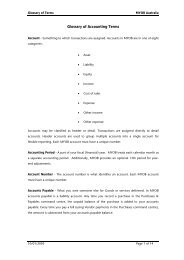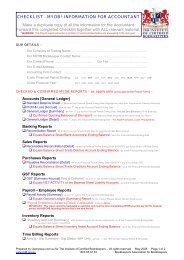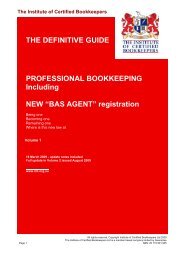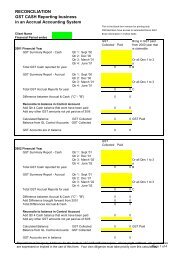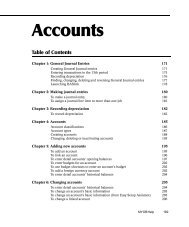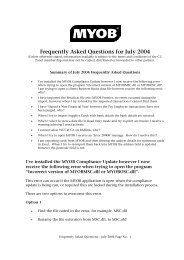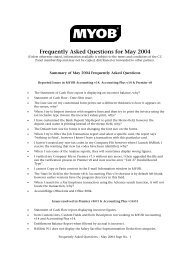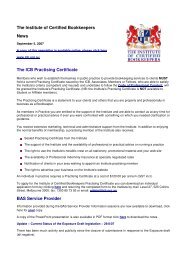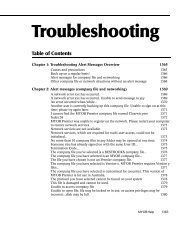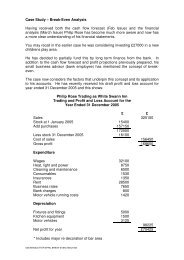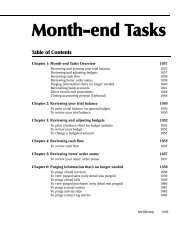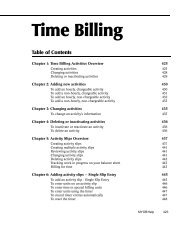Parental Leave & Related Entitlements
Parental Leave & Related Entitlements
Parental Leave & Related Entitlements
Create successful ePaper yourself
Turn your PDF publications into a flip-book with our unique Google optimized e-Paper software.
<strong>Parental</strong> leave and related entitlements and the<br />
National Employment Standards<br />
Australia’s new workplace relations system<br />
From 1 July 2009, most Australian workplaces are governed by a new system created by the Fair Work Act 2009.<br />
The Fair Work Ombudsman helps employees, employers, contractors and the community to understand and<br />
comply with the new system. We provide education, information and advice, investigate workplace complaints,<br />
and enforce relevant Commonwealth workplace laws.<br />
<strong>Parental</strong> leave and related entitlements form part of<br />
the National Employment Standards (NES). As of<br />
1 January 2010, the NES apply to all employees covered<br />
by the national workplace relations system, regardless<br />
of the applicable industrial instrument or contract of<br />
employment.<br />
Terms in awards, agreements and employment contracts<br />
cannot exclude or provide for an entitlement less than<br />
the NES, and have no effect. An employer must not<br />
contravene a provision of the NES. A contravention of<br />
a provision of the NES may result in penalties of up to<br />
$6,600 for an individual and $33,000 for a corporation.<br />
In addition to the NES, an employee’s terms and<br />
conditions of employment generally come from an award<br />
or agreement. All references to an award or agreement<br />
in this fact sheet include modern awards, enterprise<br />
agreements, and award or agreement-based transitional<br />
instruments.<br />
Overview<br />
The NES establish minimum entitlements to unpaid<br />
parental leave and related entitlements, which apply to all<br />
employees in Australia.<br />
<strong>Parental</strong> leave provisions include birth-related leave and<br />
adoption-related leave, and also recognise same sex de<br />
facto relationships.<br />
In addition to unpaid parental leave, the NES also provide<br />
the following related entitlements:<br />
• unpaid special maternity leave<br />
• a right to transfer to a safe job in appropriate cases, or<br />
take paid ‘no safe job leave’<br />
• consultation requirements<br />
Fair Work Infoline: 13 13 94<br />
• a return to work guarantee<br />
• unpaid pre-adoption leave.<br />
Which employees are eligible for<br />
unpaid parental leave?<br />
All employees in Australia are eligible to unpaid parental<br />
leave if they have completed at least 12 months of<br />
continuous service with their employer.<br />
This includes casual employees, but only if:<br />
• they have been employed by the employer on a<br />
regular and systematic basis for a sequence of periods<br />
over at least 12 months<br />
• had it not been for the birth (or expected birth) or<br />
adoption (or expected adoption) of a child, they<br />
would have a reasonable expectation of continuing<br />
employment by the employer on a regular and<br />
systematic basis.<br />
What is the entitlement to parental<br />
leave?<br />
Each eligible member of an employee couple may take<br />
a separate period of up to 12 months of unpaid parental<br />
leave. However, if only one person is taking leave, or if one<br />
member of an employee couple wishes to take more than<br />
12 months leave, the employee may request a further<br />
period of up to 12 months, from their employer.<br />
An ‘employee couple’ is where two employees are in a<br />
spousal or de facto relationship.<br />
<strong>Parental</strong> leave is only available to employees who have or<br />
will have responsibility for the care of a child.<br />
www.fairwork.gov.au<br />
Page: 1
The leave must be associated with:<br />
• the birth of a child to the employee, the employee’s<br />
spouse, or the employee’s de facto partner or<br />
• the placement of a child under 16 with the employee<br />
for adoption.<br />
The ‘child of a person’ is defined by the Family Law Act 1975<br />
as someone who is a person’s biological, adopted or step<br />
child.<br />
An employee’s ‘de facto partner’ is defined as a person<br />
who, although not legally married to the employee, lives<br />
with them in a relationship as a couple on a genuine<br />
domestic basis. Former de facto partners are also included.<br />
The Fair Work Act 2009 ensures that same sex de facto<br />
relationships are recognised for unpaid parental leave<br />
entitlements. This means that the same sex de facto<br />
partner of either a person who gives birth or a biological<br />
parent may be eligible to take unpaid birth-related leave.<br />
What are the rules for taking unpaid<br />
parental leave?<br />
There are different rules for taking unpaid parental leave,<br />
depending on:<br />
• if one employee takes leave or<br />
• if both members of an employee couple take leave.<br />
One employee taking unpaid parental leave<br />
The following rules apply where one employee (or only<br />
one member of an employee couple) takes leave:<br />
• leave must be taken in a single continuous period<br />
(paid leave, such as annual leave, may be taken at the<br />
same time)<br />
• leave starts at the birth or placement of the child or,<br />
in the case of a pregnant employee, up to six weeks<br />
before the expected date of birth<br />
• leave may start at any time within 12 months after the<br />
birth or placement of the child if:<br />
––<br />
the employee has a spouse or de facto partner who<br />
is not an employee<br />
––<br />
the spouse or de facto partner has responsibility for<br />
the care of the child.<br />
Both members of an employee couple taking<br />
leave<br />
The following rules apply to an employee couple if both<br />
employees take unpaid parental leave:<br />
• both employees may at the same time each take up<br />
to three weeks unpaid parental leave (reducing their<br />
overall entitlement) either immediately after the birth<br />
or placement of a child or, by agreement with the<br />
employer, at any time during an extended period<br />
starting before the birth and ending no later than six<br />
weeks after the birth or placement.<br />
Fair Work Infoline: 13 13 94<br />
• remaining leave must be taken separately in a single<br />
continuous period (paid leave, such as annual leave,<br />
may be taken at the same time)<br />
• if the employee who takes leave first is pregnant or<br />
gives birth, they may start their leave up to six weeks<br />
before the expected date of birth<br />
• if the employee who takes leave first is not pregnant,<br />
their leave must start on the date of birth or placement<br />
of a child<br />
• the second employee must start their leave<br />
immediately after the first employee’s leave finishes<br />
• they are entitled to no more than 24 months between<br />
them.<br />
Can an employee extend their unpaid<br />
parental leave?<br />
An employee taking 12 months parental leave may<br />
request an extension of a further 12 months leave (up<br />
to 24 months in total), unless they are a member of an<br />
employee couple and the other member has already<br />
taken 12 months of leave.<br />
The request must be in writing and given to the employer<br />
at least four weeks before the end of the employee’s initial<br />
period of parental leave. The employer must respond<br />
in writing within 21 days, stating whether they grant<br />
or refuse the request. They may only refuse if there are<br />
reasonable business grounds to do so, and must detail<br />
their reasons in writing.<br />
The NES do not define ‘reasonable business grounds’ for<br />
refusing a request, but relevant factors may include:<br />
• the effect on the workplace (e.g. the impact on<br />
finances, efficiency, productivity, customer service)<br />
• the inability to manage the workload among existing<br />
staff<br />
• the inability to recruit a replacement employee.<br />
Can a pregnant employee be<br />
required to take parental leave within<br />
six weeks before the birth?<br />
A pregnant employee wanting to work the six weeks<br />
before birth may be asked by the employer to provide a<br />
medical certificate containing the following:<br />
• a statement of whether the employee is fit for work<br />
• if the employee is fit for work, a statement of whether<br />
it is inadvisable for the employee to continue in her<br />
present position because of:<br />
––<br />
illness or risks arising out of the employee’s<br />
pregnancy or<br />
––<br />
hazards connected with the position.<br />
www.fairwork.gov.au<br />
Page: 2
The employer may require the employee to take a<br />
period of unpaid parental leave as soon as possible if the<br />
employee:<br />
• fails to provide the requested medical certificate within<br />
seven days of the request or<br />
• provides a certificate within seven days stating that<br />
they are not fit for work or<br />
• provides a certificate stating they are fit for work, but<br />
that it is inadvisable to continue in the present position<br />
due to illness, risk to the pregnancy, or job-related<br />
hazards<br />
• is not entitled to transfer to a safe job or to ‘no safe job<br />
leave’ (see below).<br />
This form of directed leave runs until the end of the<br />
pregnancy or until the planned leave was due to start, and<br />
is deducted from the employee’s unpaid parental leave<br />
entitlement. It is exempt from the rules about when the<br />
leave must start, that it be taken in a continuous period,<br />
and notice requirements.<br />
What are the notice and evidence<br />
requirements for taking parental<br />
leave?<br />
An employee is not entitled to take unpaid parental leave<br />
unless they:<br />
• inform their employer of their intention to take unpaid<br />
parental leave by giving at least 10 weeks notice<br />
(unless it is not possible to do so)<br />
• specify the intended start and end dates of the leave<br />
• at least four weeks before the intended start date:<br />
––<br />
confirm the intended start and end dates or<br />
––<br />
advise the employer of any changes to the<br />
intended start and end dates (unless it is not<br />
possible to do so).<br />
An employer may require evidence that would satisfy<br />
a reasonable person of the actual or expected date of<br />
birth of a child (e.g. a medical certificate), or the day or<br />
expected day of placement of a child under 16.<br />
Other entitlements related to<br />
parental leave<br />
Unpaid special maternity leave<br />
An eligible pregnant employee is entitled to take unpaid<br />
special maternity leave if the employee is not fit for work<br />
because of:<br />
• a pregnancy-related illness or<br />
• the pregnancy ends, not in the birth of a living child,<br />
within 28 weeks of the expected date of birth.<br />
An employee must give their employer notice they are<br />
taking unpaid special maternity leave as soon as possible<br />
(which may be after the leave has started), and the<br />
expected period of leave.<br />
An employer may require evidence that would satisfy a<br />
reasonable person (e.g. a medical certificate).<br />
The entitlement to unpaid parental leave is reduced by<br />
the amount of any unpaid special maternity leave taken<br />
by the employee while they are pregnant.<br />
Transfer to a safe job or ‘paid no safe job<br />
leave’<br />
An eligible pregnant employee has in specified<br />
circumstances an entitlement to be a transferred to an<br />
‘appropriate safe job’. An appropriate safe job is a safe job<br />
that has:<br />
• the same ordinary hours of work as the employee’s<br />
present position or<br />
• a different number of ordinary hours agreed to by the<br />
employee.<br />
This entitlement applies if the employee:<br />
• is entitled to unpaid parental leave<br />
• has complied with the notice and evidence<br />
requirements for accessing that unpaid parental leave<br />
• has provided evidence (e.g. a medical certificate) that<br />
would satisfy a reasonable person that they are fit for<br />
work, but that it is inadvisable for them to continue in<br />
their present position during a period because of:<br />
––<br />
illness or risks arising out of the pregnancy or<br />
––<br />
hazards connected with that position.<br />
If these requirements are met and there is an appropriate<br />
safe job available, the employee must be transferred to<br />
that job for the risk period, with no other change to the<br />
employee’s terms and conditions of employment. The<br />
employer must pay the employee at their full rate of pay 1<br />
for the position they were in before the transfer, for the<br />
hours they work in the risk period.<br />
If there is no appropriate safe job available, the employee<br />
is entitled to take paid ‘no safe job leave’ for the risk period,<br />
and be payed at their base rate of pay 2 for ordinary hours<br />
of work in the risk period.<br />
1<br />
The full rate of pay is the rate of pay payable to the employee plus incentive-based payments and bonuses, loadings, monetary allowances,<br />
overtime or penalty rates, and any other separately identifiable amounts.<br />
2<br />
The base rate of pay is the rate of pay payable to the employee for their ordinary hours of work, but not including incentive-based payments<br />
and bonuses, loadings, monetary allowances, overtime or penalty rates, and any other separately identifiable amounts.<br />
Fair Work Infoline: 13 13 94<br />
www.fairwork.gov.au<br />
Page: 3
If an employee is on paid no safe job leave during the<br />
six week period before the expected date of birth, the<br />
employer may ask the employee to give the employer a<br />
medical certificate stating whether they are fit for work.<br />
The employer may require the employee to take a period<br />
of unpaid parental leave as soon as practicable if:<br />
• the employee does not give the employer a medical<br />
certificate within seven days after the request or<br />
• within 7 days after the request, the employee provides<br />
a certificate stating they are not fit for work.<br />
The no safe job leave ends when the period of unpaid<br />
parental leave starts.<br />
Consultation requirements on unpaid<br />
parental leave<br />
Employees on unpaid parental leave are entitled to be<br />
kept informed of decisions by their employer that will<br />
have a significant effect on the status, pay or location of<br />
their pre-parental leave position. The employer must take<br />
all reasonable steps to give the employee information<br />
about (and an opportunity to discuss) the effect of any<br />
such decisions on the employee’s position.<br />
The employee’s pre-parental leave position is the position<br />
they held before starting the unpaid parental leave, or the<br />
position they held before they were transferred to a safe<br />
job or reduced their hours due to the pregnancy.<br />
Return to work guarantee<br />
An employee is guaranteed a return to work immediately<br />
following a period of unpaid parental leave, entitling them<br />
to:<br />
• their pre-parental leave position or<br />
• if that position no longer exists, an available position<br />
for which they are qualified and suited, which is<br />
nearest in status and pay to their pre-parental leave<br />
position.<br />
Unpaid pre-adoption leave<br />
All employees (regardless of their length of service) are<br />
entitled to up to two days of unpaid pre-adoption leave<br />
to attend any interviews or examinations required for the<br />
adoption of a child.<br />
This leave may be taken as:<br />
• a singe continuous period of up to two days or<br />
• any separate periods to which the employee and<br />
employer agree.<br />
An employer may, however, direct an employee to take<br />
another form of leave (e.g. paid annual leave) before<br />
accessing their unpaid pre-adoption leave entitlement.<br />
An employee must give their employer notice they are<br />
taking unpaid pre-adoption leave and the expected<br />
duration as soon as possible (which may be after the leave<br />
has started) and, if required, evidence that would satisfy a<br />
reasonable person.<br />
Further Information<br />
The Fair Work Ombudsman has published a fact sheet<br />
on each NES entitlement. For further information on a<br />
specific NES entitlement, please see the relevant fact<br />
sheets at www.fwo.gov.au<br />
For further information, visit www.fairwork.gov.au or<br />
contact Fair Work Online 13 13 94.<br />
<strong>Related</strong> publications<br />
Introduction to the NES<br />
Maximum weekly hours and the NES<br />
Requests for flexible working arrangements and the NES<br />
Annual leave and the NES<br />
Personal/carer’s leave and compassionate leave and the NES<br />
Community service leave and the NES<br />
Long service leave and the NES<br />
Public holidays and the NES<br />
Notice of termination and redundancy pay and the NES<br />
Fair Work Information Statement and the NES<br />
Contact us<br />
Fair Work Online: www.fairwork.gov.au<br />
Fair Work Infoline: 13 13 94<br />
Monday to Friday, between 8.00am−6.00pm<br />
Hearing & speech assistance<br />
Call through the National Relay Service (NRS):<br />
• For TTY: 13 36 77. Ask for the Fair Work Infoline 13 13 94<br />
• Speak & Listen: 1300 555 727. Ask for the Fair Work Infoline<br />
13 13 94<br />
Need language help?<br />
Contact the Translating and Interpreting Service (TIS)<br />
on 13 14 50<br />
Fair Work Infoline: 13 13 94<br />
This information has been provided by the Fair Work Ombudsman (FWO) as part of its function to provide education, assistance and advice<br />
(but not legal or professional service advice). The FWO does not provide this information for any other purpose. You are not entitled to rely<br />
upon this information as a basis for action that may expose you to a legal liability, injury, loss or damage. Rather, it is recommended that you<br />
obtain your own independent legal advice or other professional service or expert assistance relevant to your particular circumstances.<br />
www.fairwork.gov.au<br />
Last updated: November 2009<br />
© Fair Work Ombudsman - FWOFS26<br />
Page: 4



